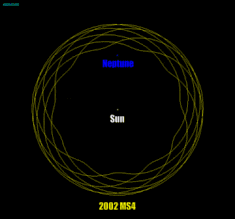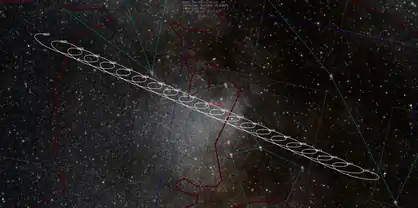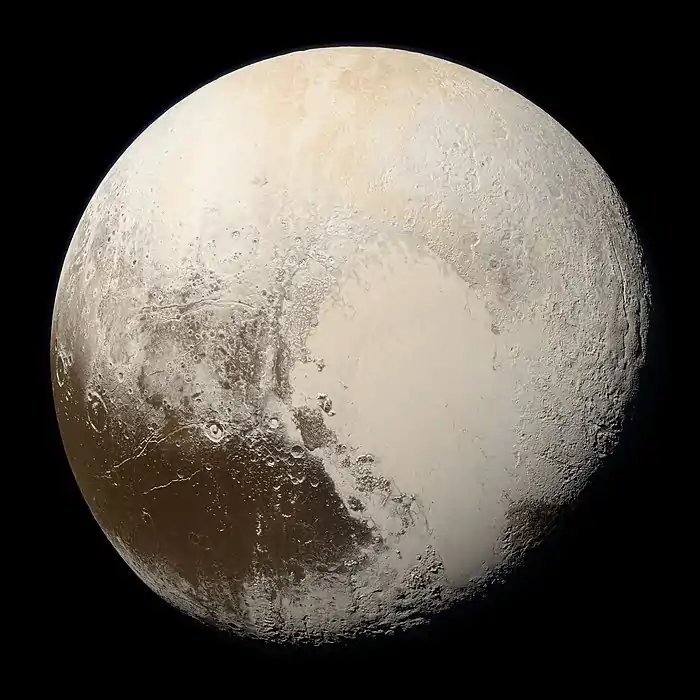(307261) 2002 MS4
(307261) 2002 MS4 is a large classical Kuiper belt object and a possible dwarf planet in the Kuiper belt, a region of icy planetesimals beyond Neptune.[3] It was discovered in 2002 by Chad Trujillo and Michael Brown. 2002 MS4 has been observed 74 times, with precovery images back to 8 April 1954.[2]
 2002 MS4 imaged by the Hubble Space Telescope on 9 April 2006 | |
| Discovery[1] | |
|---|---|
| Discovered by | Chad Trujillo Michael E. Brown |
| Discovery site | Palomar Obs. |
| Discovery date | 18 June 2002 |
| Designations | |
| 2002 MS4 | |
| TNO[2] · cubewano[3] · Scat-Ext[4] | |
| Orbital characteristics[2] | |
| Epoch 31 May 2020 (JD 2459000.5) | |
| Uncertainty parameter 3 | |
| Observation arc | 23,443 days (64.18 yr) |
| Earliest precovery date | 8 April 1954 |
| Aphelion | 47.903 AU |
| Perihelion | 36.185 AU |
| 42.044 AU | |
| Eccentricity | 0.13936 |
| 272.62 yr (99,575 d) | |
| 225.337° | |
| 0° 0m 13.015s / day | |
| Inclination | 17.683° |
| 216.019° | |
| ≈ 12 June 2123[5] ±14 days | |
| 212.541° | |
| Physical characteristics | |
| Dimensions | 808 × 748 km ± 11 km RMS (projected)[6] |
Mean diameter | 778±11 km (2020)[6] 934±47 km (2012)[7] 726±123 km (2008, thermal)[8] |
| 7.33 h or 10.44 h (single-peaked), 14.66 h or 20.88 h (double-peaked)[9] | |
| 0.051+0.036 −0.022 [7] | |
| B−V=0.69[10] V−R=0.38[10] | |
| 20.6[11] | |
| 3.6[2] 3.5±0.4 (R-band)[7] 3.8[12] | |
As of 2019, 2002 MS4 is 46.5 AU from the Sun.[11] It will reach perihelion, its closest point to the Sun, in 2122.[2] At nearly 800 km in diameter, it is approximately tied (to within measurement uncertainties) as the largest unnamed object in the Solar System and is also tied as the largest known planetoid without a moon.
History
Discovery

2002 MS4 was discovered on 18 June 2002 by Chad Trujillo and Michael Brown at Palomar Observatory. The discovery was announced by the Minor Planet Center on 21 November 2002.[1]
In 2007, an archive search revealed the existence of several precovery observations of 2002 MS4, the earliest of which was taken on 8 April 1954, as part of the Digitized Sky Survey at Palomar Mountain.[13][2]

In July 2016, 2002 MS4 was observed by the New Horizons spacecraft, as part of its extended Kuiper belt mission. The observations significantly improved the knowledge of 2002 MS4's orbit and phase curve.[14][15]
As of November 2019, 2002 MS4 has been observed 74 times. It has an observation arc of 64 years.[2]
Orbit and classification
2002 MS4 is similar in orbit and current position to Quaoar, although with higher eccentricity and inclination, orbiting every 272.6 years. 2002 MS4 belongs to the class of dynamically hot Kuiper belt objects.[16] It is in an intermittent 18:11 orbital resonance with Neptune.[17]


Physical characteristics
The Spitzer Space Telescope estimated it to have a diameter of 726±123 km, while the Herschel Space Telescope estimated it to be 934±47 km.[8] If the latter case is true, 2002 MS4 would be comparable in size to the dwarf planet Ceres, and would also be the largest Solar System object without a name as of 2020.[8][lower-alpha 1] 2002 MS4 is one of the 10 largest TNOs currently known[7] and large enough to be considered a dwarf planet under the 2006 draft proposal of the IAU.[19] A stellar occultation by 2002 MS4 was observed on 26 July 2019 from British Columbia, with a single chord of 831 km.[20] Another stellar occultation on 19 August 2019 suggested that 2002 MS4 may be highly oblate in shape, with a projected dimension of 842 × 688 km.[21] Another stellar occultation on 8 August 2020, with at least 21 positive detections, resulted in a projected size of 808 × 748 km.[6]
2002 MS4 does not have any known moons orbiting it, thus an accurate mass estimate cannot be made. Based on its size, Brown lists it as nearly certain to be a dwarf planet,[22] however, its low albedo may imply the opposite: dark, mid-sized bodies such as this, less than about 1000 km in diameter and with albedos less than about 0.2, have likely never collapsed into solid bodies, much less differentiated or relaxed into hydrostatic equilibrium, and thus are unlikely to be dwarf planets.[23]
As of 2019, the rotation period of 2002 MS4 is unknown. Observations in 2005 and 2011 showed possible periods of either 7.33 hours or its alias 10.44 hours (single-peaked), or twice those values for the double-peaked solution, with a small light curve amplitude of 0.05±0.01 mag. Light curve observations of 2002 MS4 are difficult because of the dense field of background stars it is crossing. Observations made in June and July 2011 took advantage of 2002 MS4 moving in front of a dark nebula.[9]
See also
Notes
- Prior to February 2020, the scattered-disc object and possible dwarf planet 225088 Gonggong did not have an official name, but was known by its provisional designation 2007 OR10. Until then, 2007 OR10 was the largest unnamed Solar System object.[18]
References
- "MPEC 2002-W27 : 2002 MS4, 2002 QX47, 2002 VR128". IAU Minor Planet Center. 21 November 2002. Retrieved 26 August 2009.
- "JPL Small-Body Database Browser: 307261 (2002 MS4)" (2018-06-14 last obs.). Jet Propulsion Laboratory. 13 July 2019. Retrieved 20 February 2020.
- "MPEC 2009-P26 :Distant Minor Planets (2009 AUG. 17.0 TT)". IAU Minor Planet Center. 7 August 2009. Retrieved 31 August 2009.
- Buie, M.W. (3 May 2008). "Orbit Fit and Astrometric record for 02MS4". SwRI (Space Science Department). Archived from the original on 4 June 2011. Retrieved 31 August 2009.
- JPL Horizons Observer Location: @sun (Perihelion occurs when deldot changes from negative to positive. Uncertainty in time of perihelion is 3-sigma.)
- "2020/08/08 - 307261 - 2002 MS4 - 4UC419-096262". euraster.net. Euraster. 16 August 2020. Retrieved 31 August 2020.
- Vilenius, E.; Kiss, C.; Mommert, M.; et al. (2012). ""TNOs are Cool": A survey of the trans-Neptunian region VI. Herschel/PACS observations and thermal modeling of 19 classical Kuiper belt objects". Astronomy & Astrophysics. 541: A94. arXiv:1204.0697. Bibcode:2012A&A...541A..94V. doi:10.1051/0004-6361/201118743. S2CID 54222700.
- Stansberry, J.; Grundy, W.; Brown, M.; Cruikshank, D.; et al. (2008). "Physical Properties of Kuiper Belt and Centaur Objects: Constraints from Spitzer Space Telescope". In Barucci, M. A. (ed.). The Solar System Beyond Neptune. University of Arizona Press. pp. 161–180. arXiv:astro-ph/0702538. ISBN 9780816527557.
- Thirouin, A. (2013), Study of Trans-Neptunian Objects using photometric techniques and numerical simulations (dissertation) (PDF), Granada, pp. 92–95, retrieved 19 November 2019
- Tegler, S.C. (26 January 2006). "Kuiper Belt Object Magnitudes and Surface Colors". Archived from the original on 16 November 2007. Retrieved 5 November 2006.
- "AstDyS 2002MS4 Ephemerides". Department of Mathematics, University of Pisa, Italy. Archived from the original on 19 November 2019. Retrieved 19 November 2019.
- "AstDyS 2002 MS4 Summary". Department of Mathematics, University of Pisa, Italy. Archived from the original on 19 November 2019. Retrieved 19 November 2019.
- Minor Planets and Comets Supplement (PDF), Minor Planet Center, 30 December 2007, p. 231732, retrieved 19 November 2019
- Lakdawalla, E. (24 January 2018). "New Horizons prepares for encounter with 2014 MU69". The Planetary Society. Retrieved 13 November 2019.
- Verbiscer, A.; Porter, S.; Spencer, J.R.; Buie, M.W.; et al. (2017), "New Horizons High-Phase Observations of Distant Kuiper Belt Objects", AGU Fall Meeting Abstracts, 2017: P11C–2528, Bibcode:2017AGUFM.P11C2528V
- Treatise on Geophysics. 1 (2 ed.). Elsevier. 2015. p. 643. ISBN 9780444538031. Retrieved 19 November 2019.
- Buie, M.W. "Orbit and Astrometry for 307261". Retrieved 19 November 2019.
- "M.P.C. 121135" (PDF). Minor Planet Circular. Minor Planet Center. 5 February 2020. Retrieved 20 February 2020.
- Gingerich, O. (16 August 2006). "The Path to Defining Planets" (PDF). Harvard-Smithsonian Center for Astrophysics and IAU EC Planet Definition Committee chair. p. 4. Retrieved 13 March 2007.
- Ceravolo, D.; Ceravolo, P. (26 July 2019). "(307261) 2002 MS4, 2019 July 26 occultation". asteroidoccultation.com. Retrieved 19 November 2019.
- Ceravolo, D.; Ceravolo, P. (19 August 2019). "(307261) 2002 MS4, 2019 Aug 19 occultation". asteroidoccultation.com. Retrieved 19 November 2019.
- Brown, M. E. "How many dwarf planets are there in the outer solar system? (updates daily)". California Institute of Technology. Archived from the original on 18 October 2011. Retrieved 25 August 2011.
- Grundy, W.M.; Noll, K.S.; Buie, M.W.; Benecchi, S.D.; et al. "The Mutual Orbit, Mass, and Density of Transneptunian Binary Gǃkúnǁʼhòmdímà ((229762) 2007 UK126)". Icarus. doi:10.1016/j.icarus.2018.12.037. Archived from the original on 2019-04-07. Retrieved 2019-04-09.


_(cropped).jpg.webp)
